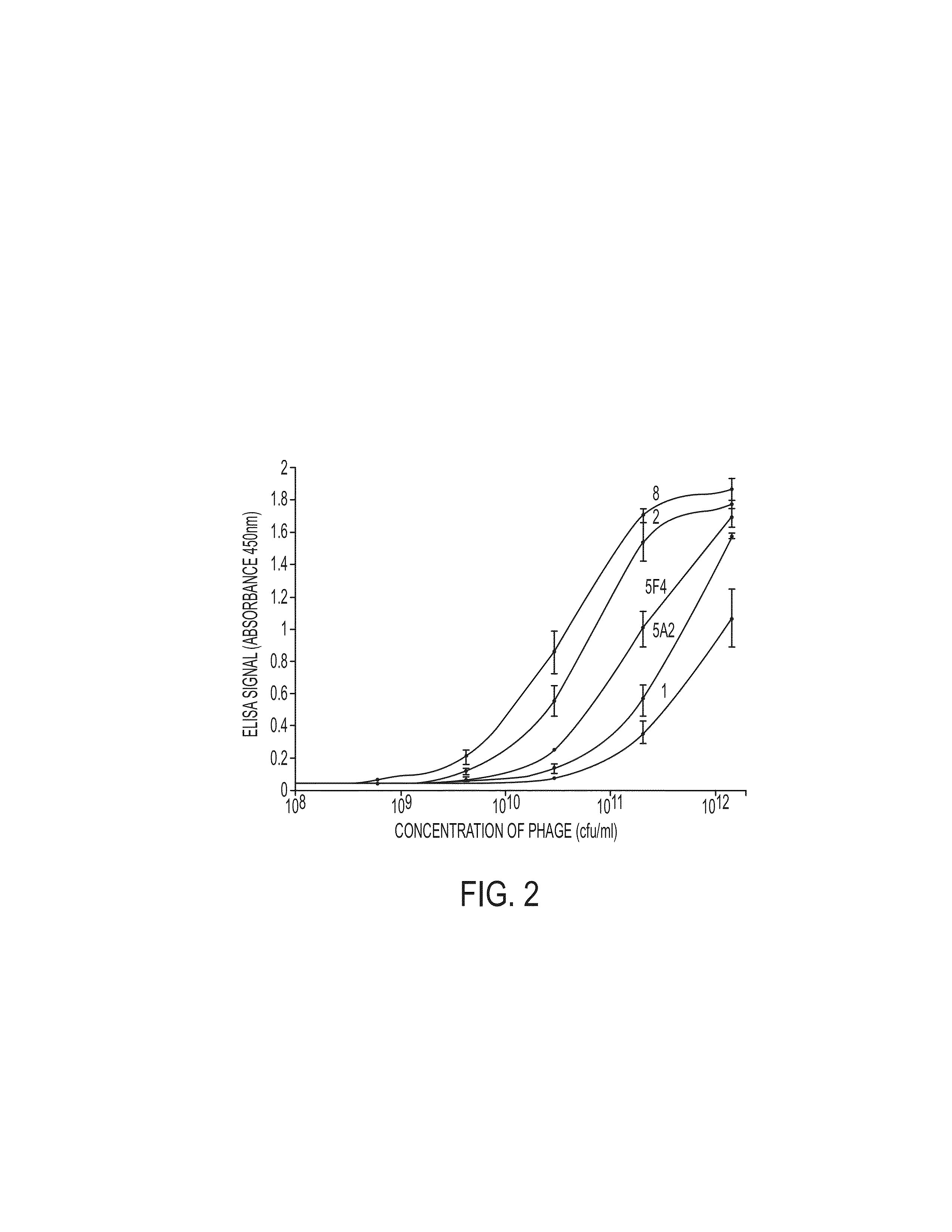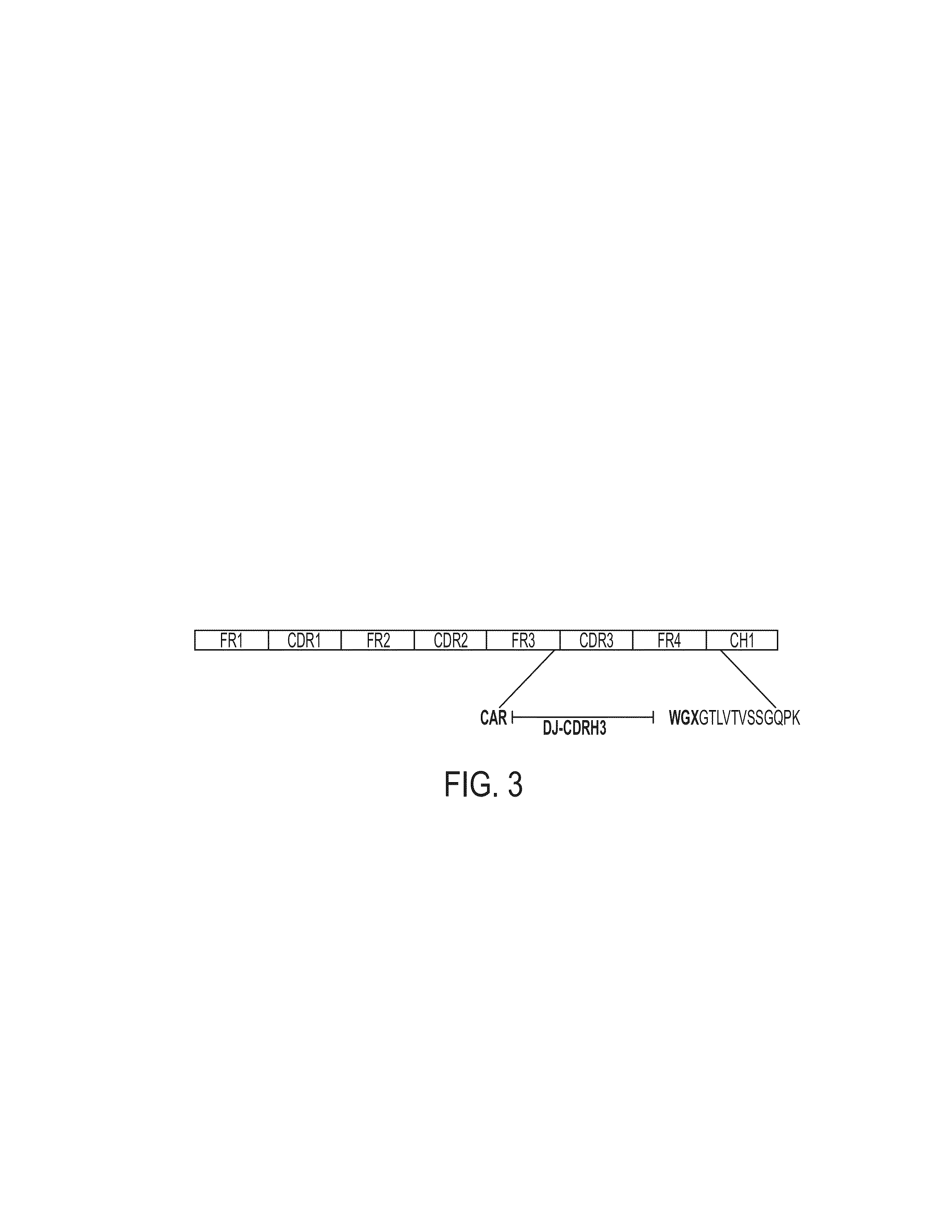Proteomic identification of antibodies
a proteomic and antibody technology, applied in the field of proteomic identification of antibodies, can solve the problems of inability to detect, human antibodies also suffer from the problem of codon usage, and the cost of considerable technical complexity
- Summary
- Abstract
- Description
- Claims
- Application Information
AI Technical Summary
Benefits of technology
Problems solved by technology
Method used
Image
Examples
example 1
Processing of Serum Antibodies from an Immunized Rabbit for Mass Spectrometry Analysis
[0178]High titer immunized mammal serum (2.5 mL, e.g., Concholepas concholepas hemocyanin (CCH), Pierce, Ill.) was diluted 4-fold in PBS and IgG proteins were purified by affinity chromatography using a protein A agarose (Pierce, Ill.) column in gravity mode. Diluted serum was recycled six times through the protein A affinity column and then the column was washed with PBS followed by elution of IgG using 100 mM glycine, pH 2.7.
[0179]Approximately 10 mg of protein A-purified serum IgG was digested with pepsin to produce F(ab)2 fragments using 500 μL of immobilized pepsin agarose (Pierce, Ill.) in 20 mM sodium acetate, pH 4.5, and digestion was allowed to proceed for seven hours, shaking vigorously at 37° C. The degree of digestion was evaluated by non-reducing 4%-20% SDS-PAGE (FIG. 1).
[0180]Affinity chromatography for the isolation of antigen-specific IgG-derived F(ab)2 was carried out by coupling t...
example 2
Detection of MS Peptide Mis-Identification by Exploiting Differential L-Cys Labeling
[0184]The resulting spectra from Example 1 were searched against a protein sequence database consisting of a rabbit full protein-coding sequence database (OryCun2) and common contaminant proteins combined with in-house rabbit VH and VL sequences, using SEQUEST® and Percolator (Proteome Discoverer 1.2, Thermo Scientific) to generate a high-confidence dataset of top-ranked protein-spectrum matches (PSMs) at H and VL sequences with ≧2 reads were included in the search. The search specified tryptic peptides with up to two missed tryptic cleavages allowed. A precursor mass tolerance of 5 ppm was used, with fragment mass tolerance set to 0.5 Da for spectra generated by CID and 0.02 Da for spectra generated by HCD. Static cysteine modifications of either carbamidomethylation (iodoacetamide, +57.021) or ethanolyl (iodoethanol, +44.026) were included based on which modifying reagent was used. Oxidized methion...
example 3
Development of Novel Bioinformatic Filters for the Correct Identification of Peptide Sequences from High-Resolution Mass Spectrometry Data of Serum Antibodies
[0186]Standard bioinformatics filters for mass spectrometry analysis of highly complex peptide mixtures involve evaluation of individual spectra independent of cumulative information derived from related spectra originating from the same parent ion. By grouping spectra based on relation to one another, more precise filters can be employed to better discriminate between correct and incorrect sequence identifications. Spectra identified by SEQUEST® as belonging to the same peptide sequence were grouped, and an average was calculated for the difference between the observed experimental mass of parent ions and the theoretical mass of the sequence. This average mass deviation (AMD) was effective in differentiating between “true” and “false” identifications determined by differential cysteine labeling (FIG. 6), and was used as a filt...
PUM
| Property | Measurement | Unit |
|---|---|---|
| threshold | aaaaa | aaaaa |
| threshold | aaaaa | aaaaa |
| threshold | aaaaa | aaaaa |
Abstract
Description
Claims
Application Information
 Login to View More
Login to View More - R&D
- Intellectual Property
- Life Sciences
- Materials
- Tech Scout
- Unparalleled Data Quality
- Higher Quality Content
- 60% Fewer Hallucinations
Browse by: Latest US Patents, China's latest patents, Technical Efficacy Thesaurus, Application Domain, Technology Topic, Popular Technical Reports.
© 2025 PatSnap. All rights reserved.Legal|Privacy policy|Modern Slavery Act Transparency Statement|Sitemap|About US| Contact US: help@patsnap.com



